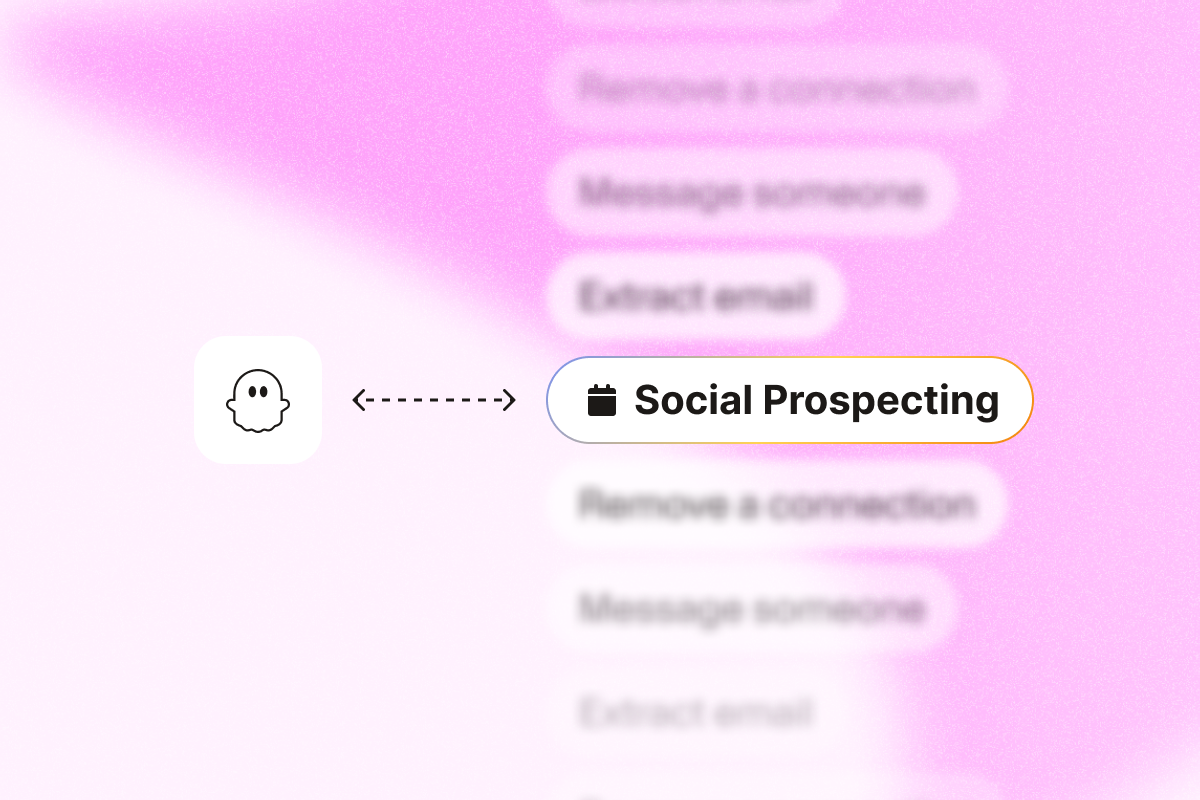Social media is a valuable channel for lead generation, and social prospecting is a way to tap into that potential. Think of it as your playbook for finding prospective new customers through social media conversations.
This guide will show you how to maximize your social media prospecting efforts, choose the right social media prospecting platforms, and attract potential prospects.
Key takeaways: Social prospecting in a nutshell
- Social prospecting is about building relationships with high-potential leads on social media by leveraging their online activity.
- The best platforms are LinkedIn (B2B leads), X (real-time conversations), Facebook (demographic targeting), and Instagram (visual content).
How to build lists of potential customers enabled by social prospecting:
| Technique | Description (What It Does & How) | PhantomBuster Solution |
| Use advanced search | Find the right profiles by combining keywords and filters, and update as the ICP changes. | LinkedIn Search Export |
| Source leads from event attendees or relevant groups | Build a list of highly engaged prospects who have already shown interest in a specific topic. | LinkedIn Event Guests Export |
| Find warm leads | Find those with intentions on what services or products are offered. | LinkedIn Post Commenter and Liker Scraper |
| Leverage AI to personalize messages | Use extracted data to understand how to engage leads using your new connections. | AI LinkedIn Message Writer |
Social prospecting best practices:
| Best Practice | Key Takeaway |
| Prioritize the right platforms | Analyze and prioritize platforms to maximize your resources and focus on where your ideal customer profile (ICP) and its habits align to extract the best resources. |
| Automate all list building and outreach | Save time by reducing hours and efforts with automated outreach, which is best for building relationships. |
| Take the time to warm up connections | Before automating, use personalized invitations by commenting on posts and interacting with content to establish connections. |
| Time outreach to stay relevant | You’ll be successful by connecting with others and sharing about your services within 24 hours of an engagement. |
| Focus on quality | Maximize profits by only extracting the right leads that fit your business. |
- Ready to put this into action? Use PhantomBuster to automate key social prospecting steps, from list building to personalized outreach. Start a 14 days free trial today!
What is social prospecting?
Social prospecting is about finding and connecting with potential leads on social media by using their online activity, shared connections, and relevant conversations to start relationships. It’s targeted lead generation, not mass messaging. This process involves creating personalized outreach messages based on thorough research, ensuring meaningful connections.
According to LinkedIn, 78% of businesses that use social selling outperform those that don’t, highlighting its effectiveness.
For example, instead of cold-messaging every marketing manager, you’d want to find those who commented on a post about “marketing automation challenges” (if you sell automation software) and connect by mentioning their comment. This shows you’re paying attention and have a shared interest.
Best social media channels for social media prospecting
For effective social prospecting, choose platforms that provide the data you need for lead qualification, allow for direct engagement with prospects, and align with your target audience (primarily B2B vs. B2C). Here’s a breakdown:
| Social channel | Why use it for social prospecting? |
| Ideal for B2B prospecting: LinkedIn provides the richest data for B2B prospecting. Access detailed professional profiles (job history, skills, company info). Find decision-makers, track company changes, and connect through shared contacts. | |
| X (Formerly Twitter) | Real-time insights: Use social listening (hashtags, keywords) to identify prospects discussing industry pain points or seeking solutions. Engage directly in relevant conversations. |
| Targeted demographics: Use detailed demographic filters to reach specific audiences. Connect with local businesses through Facebook Pages and Groups. | |
| Visual engagement (limited prospecting): This is primarily used for brand building and reaching younger demographics. There is less direct prospecting value, except for location-based businesses. |
We recommend starting with LinkedIn for most B2B sales teams and supplementing with other platforms as needed, based on your specific target audience and prospecting strategy.
Don’t spread yourself too thin. Focus on channels with the highest potential for finding and connecting with qualified leads. Narrowing your target audience improves social prospecting conversion rates, making your efforts more effective and efficient.
Best techniques for social prospecting using social media platforms
While your competition sends cold emails with low open rates, you’ll start conversations with potential clients based on shared interests. LinkedIn found that businesses prioritizing social selling are 51% more likely to reach their sales quota, emphasizing the value of this approach.
Social prospecting is about building relationships that naturally attract leads. Here’s how to make the most of it.
Use LinkedIn’s advanced search filters to identify potential customers
LinkedIn lets you pinpoint relevant leads by combining keywords and filters. Consider criteria like job title, company, location, shared interests, and years in current position.
For example, if you’re targeting a US software engineer who’s worked at Google and follows Bill Gates, you can refine your search to find potential customers.
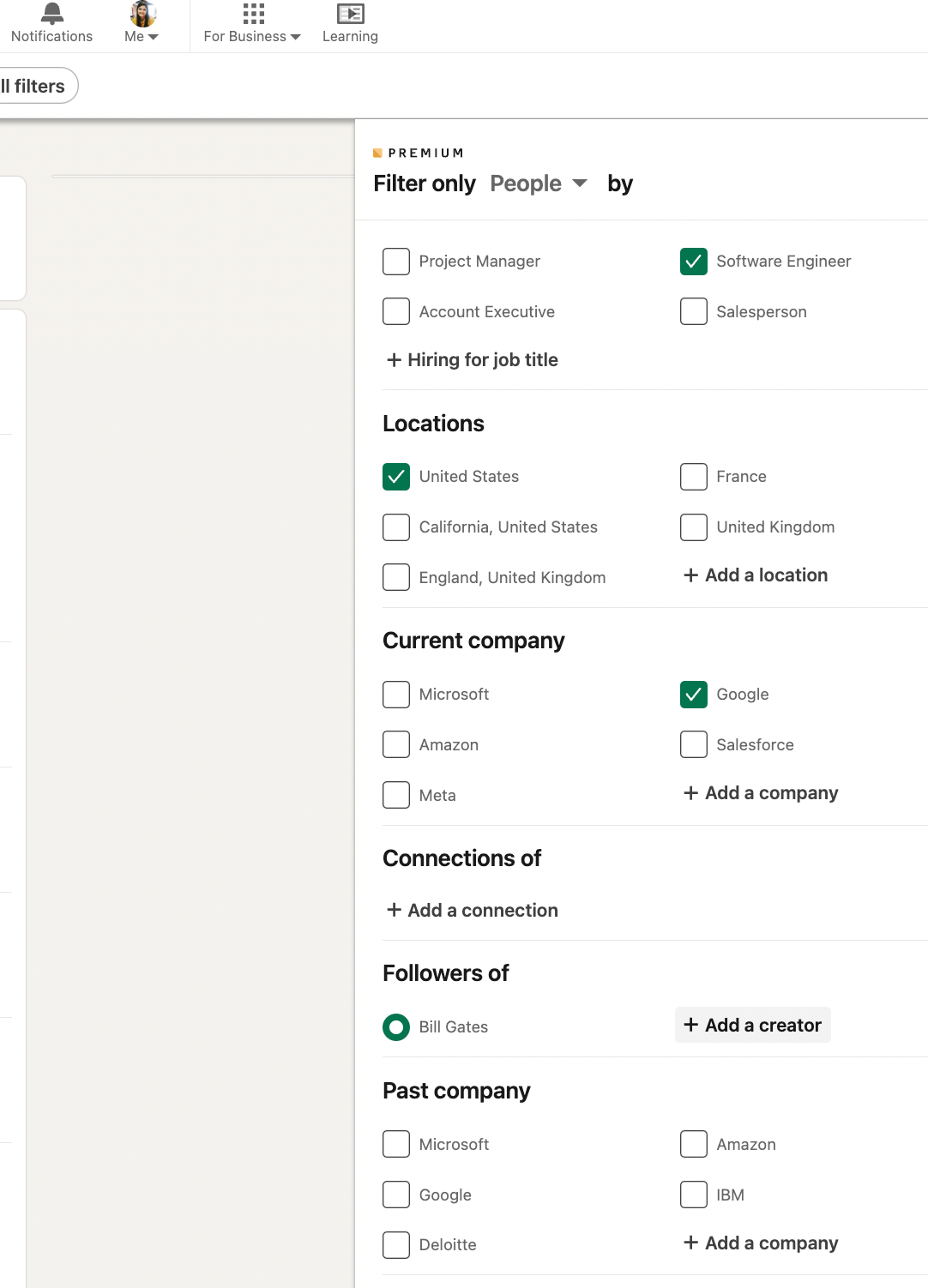
Here’s how to refine your search:
- Combine filters: Use multiple filters to create highly targeted searches.
- Leverage shared interests: Find prospects who share common connections, groups, or interests.
- Focus on tenure: Filter by years in their current position to identify professionals with established experience.
- Save your searches: Receive automatic updates when new leads match your criteria, keeping your pipeline fresh without manual effort.
Boolean operators, including AND, OR, NOT, quotation marks (” “), and parentheses ( ), help you cover more ground while maintaining search accuracy. If influencer marketers are your target audience, here’s a search example using relevant keywords:
(partnerships OR creator OR influencer OR affiliate) AND (marketing OR brand).

Export lists and segment them
Now that you know how to use LinkedIn’s advanced search to find the right prospects, what’s next? You’ll want to export those lists to segment your leads and refine your outreach.
LinkedIn Sales Navigator doesn’t offer the functionality to export lead lists. However, you can use prospecting automation tools that offer HubSpot integrations to sync your Sales Navigator lists into your CRM.
We recommend PhantomBuster’s Sales Navigator Search Export as it helps you achieve the same result with fewer bugs and at a lower cost.
You only need the URL of the search results (or a search query).
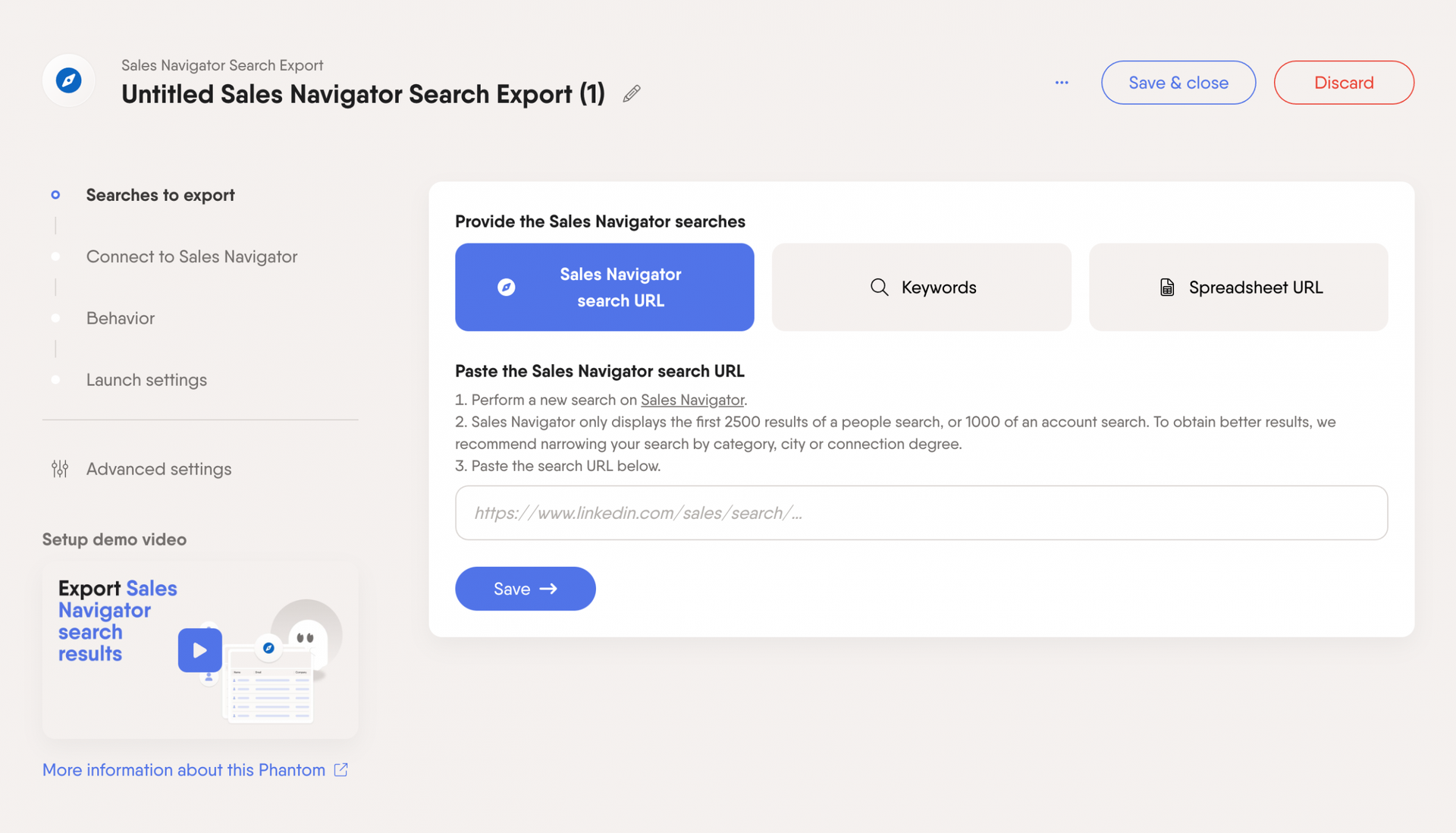
Use it to source over 2,500 leads daily and automatically sync them into your CRM. Just schedule the Phantom on repeat, and it’ll export leads to your CRM even when you’re logged off or your computer is off.
Next, segment your leads.
PhantomBuster saves the extracted data allowing you to filter it and create targeted micro-lists based on different criteria. Segmentation enables targeted messaging to specific groups of prospects, increasing engagement.
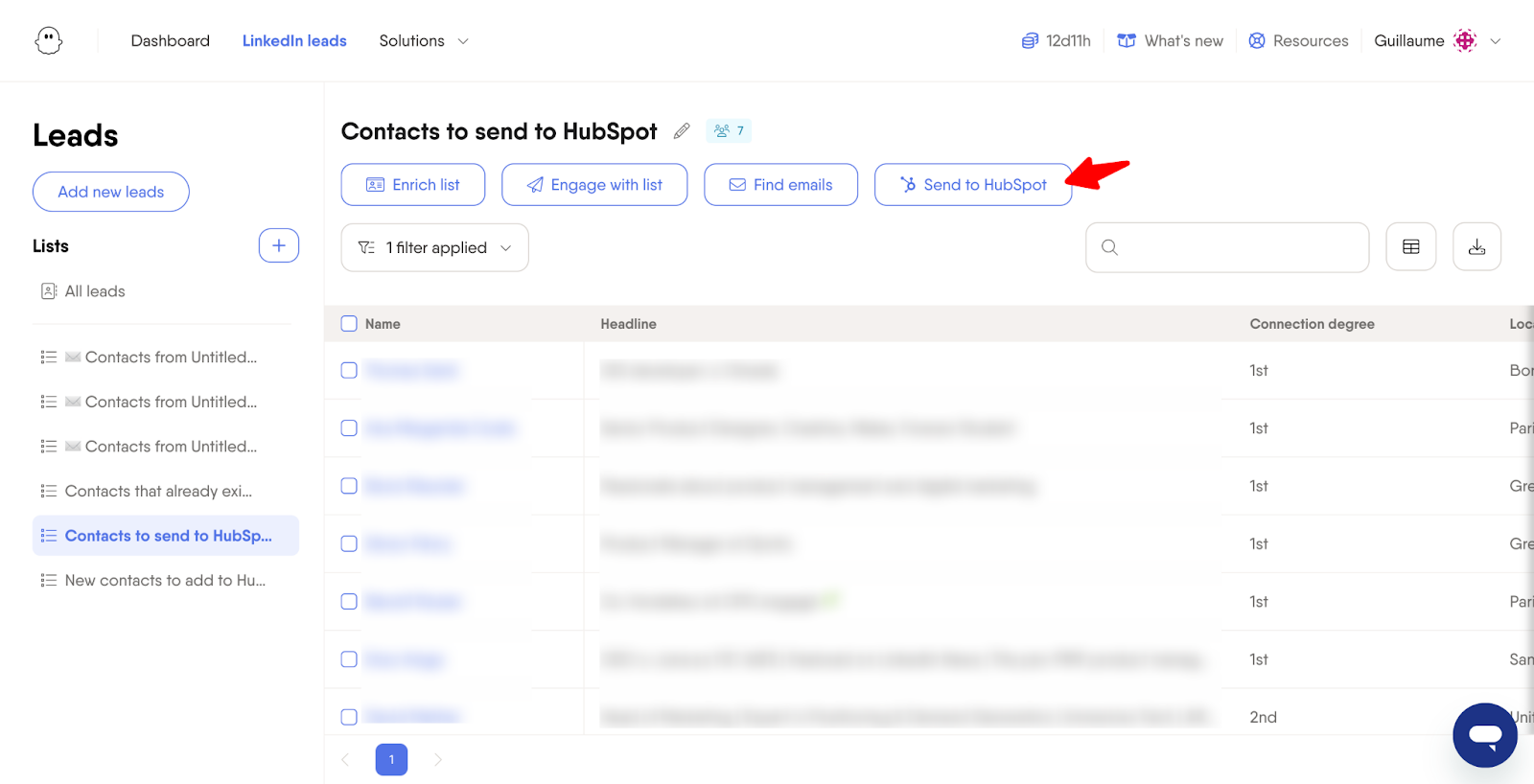
To make the most of this technique, extract lists regularly to keep your data fresh and identify trends.
Identify prospects based on intent signals
Instead of relying solely on job titles and company size, focus on intent signals. These online behaviors reveal a prospect’s genuine interest in your industry or solution. This is how you find the most receptive leads.
Think about it.
Someone who actively comments on a competitor’s LinkedIn post about a new industry trend is engaged and interested. They’re far more likely to respond positively to your outreach than someone who fits your target demographic.
To leverage intent signals for smarter prospecting, identify key influencers, industry leaders, or competitors sharing content relevant to your target audience.
Then, instead of manually tracking who’s engaging, use PhantomBuster’s Post Commenter and Liker Scraper to extract engagers automatically. This gives you a list of highly targeted leads ready for personalized outreach.
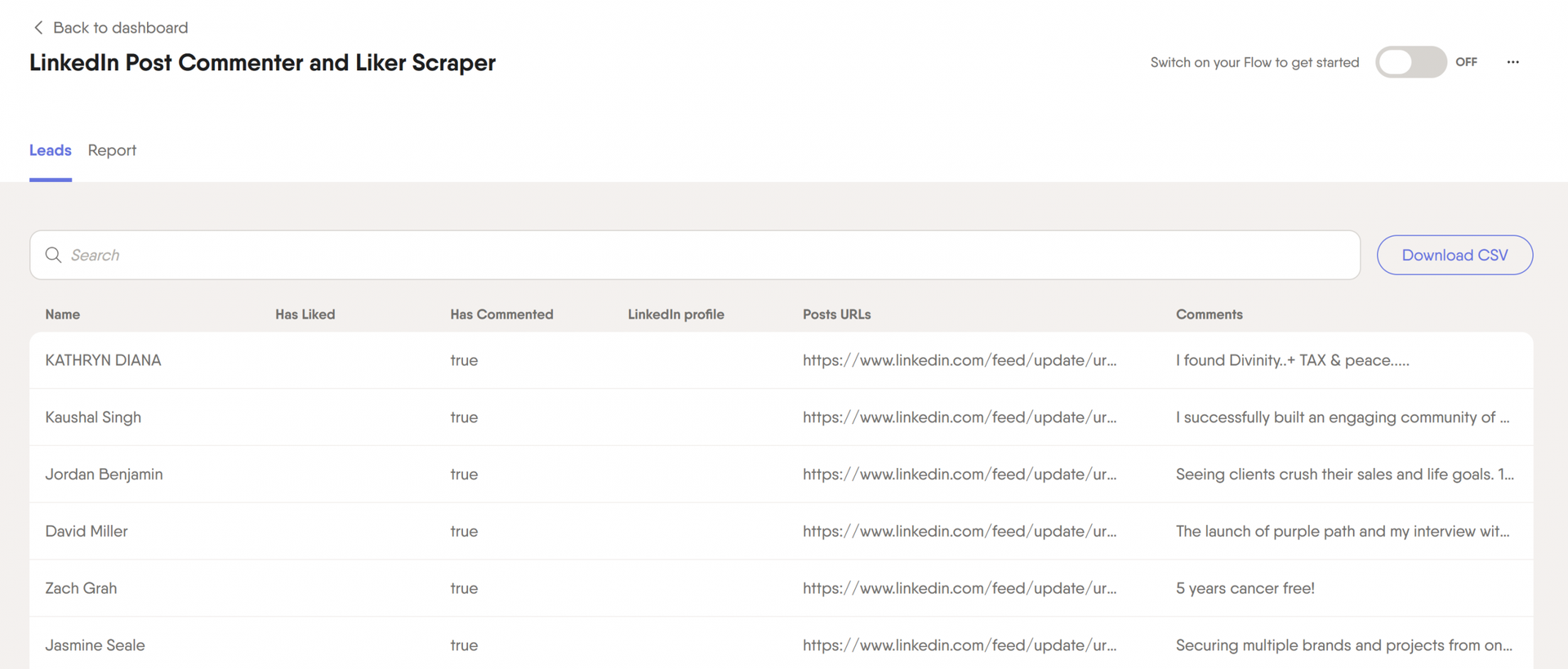
Before reaching out, look closely at how these prospects are engaging. Use this information, and write personalized messages addressing their interests and pain points.
For example, if a prospect commented on a post about the challenges of implementing AI in sales, your message could say: “I saw your comment on [Influencer’s] post about AI implementation. We’ve helped other companies overcome those challenges by…”
By focusing on intent, you’ll move beyond generic prospecting and start building genuine connections with people interested in what you offer.
Export people who attended events to find prospects
LinkedIn Events offer a direct line to interested prospects. Attendees have already shown interest in a specific topic, making them more likely to engage with your outreach.
Here’s how to connect with this audience:
First, identify relevant LinkedIn Events. Look for events focused on your industry, target audience, or a specific problem your solution addresses.
Then, use PhantomBuster’s LinkedIn Event Guests Export automation to quickly build a list of attendees.
Note: You’ll need to be an attendee to extract the full list.
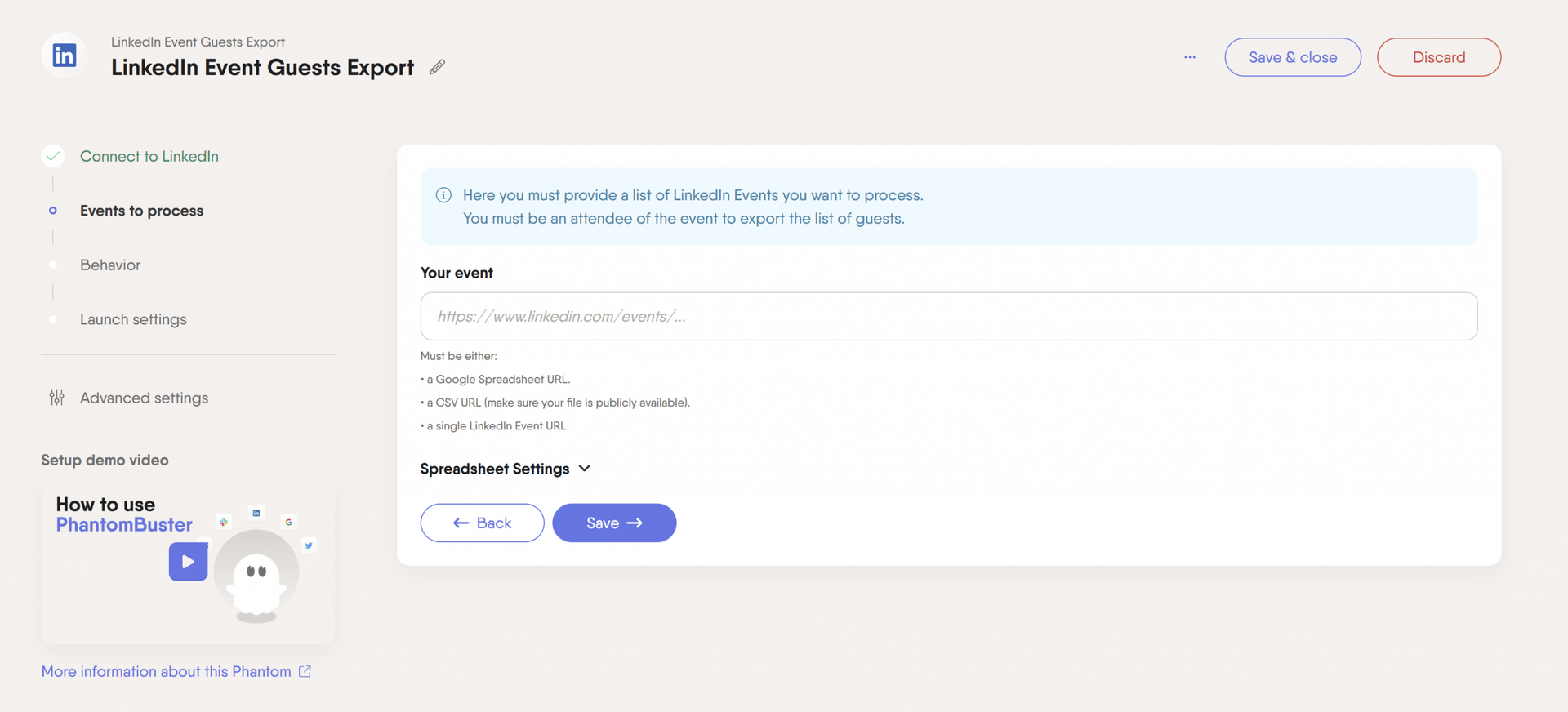
This gives you a focused list of leads.
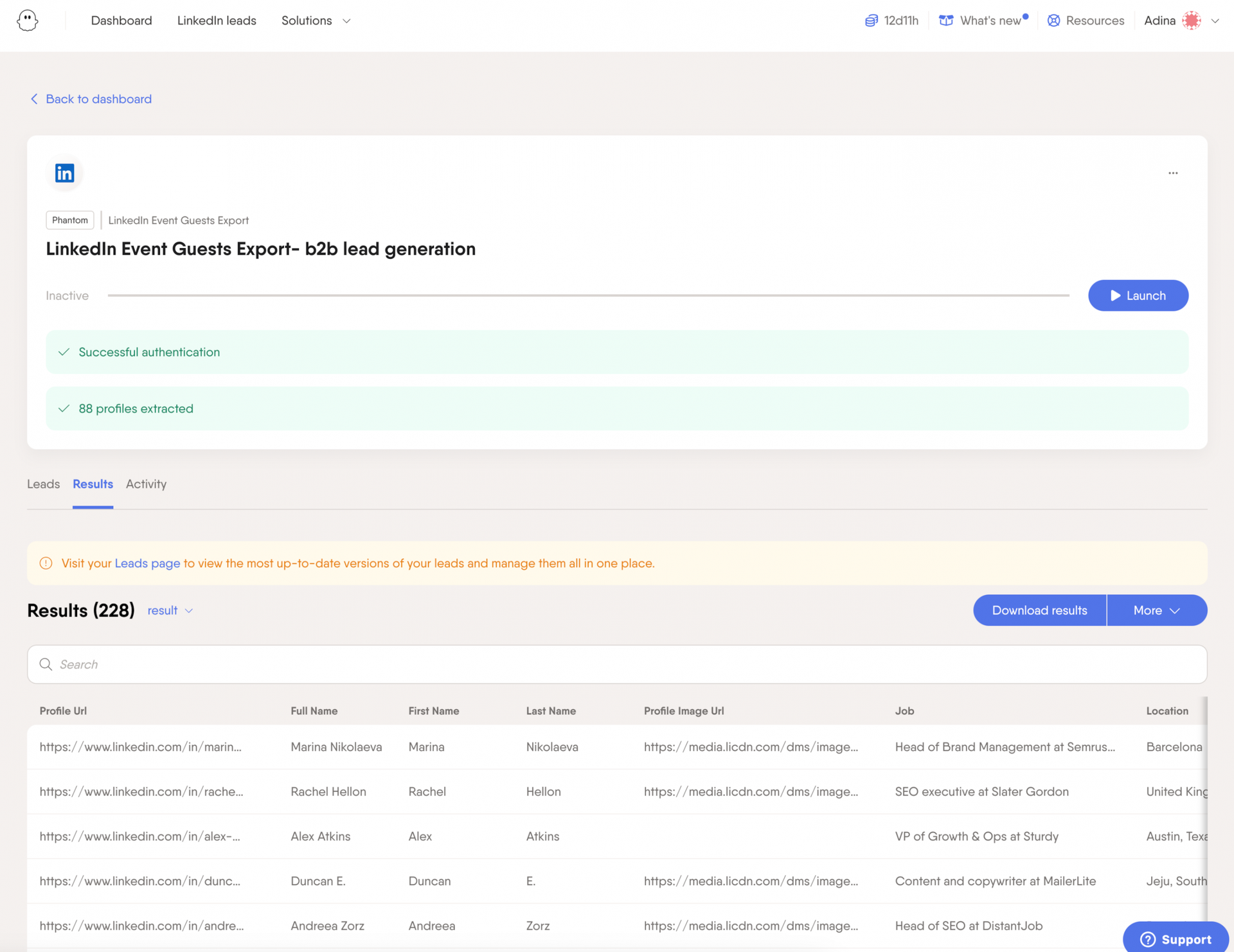
You can filter your prospect list by job title, company, or industry to prioritize high-value prospects. Write personalized outreach messages while the event is fresh in their minds, referencing key takeaways or discussions from the event itself.
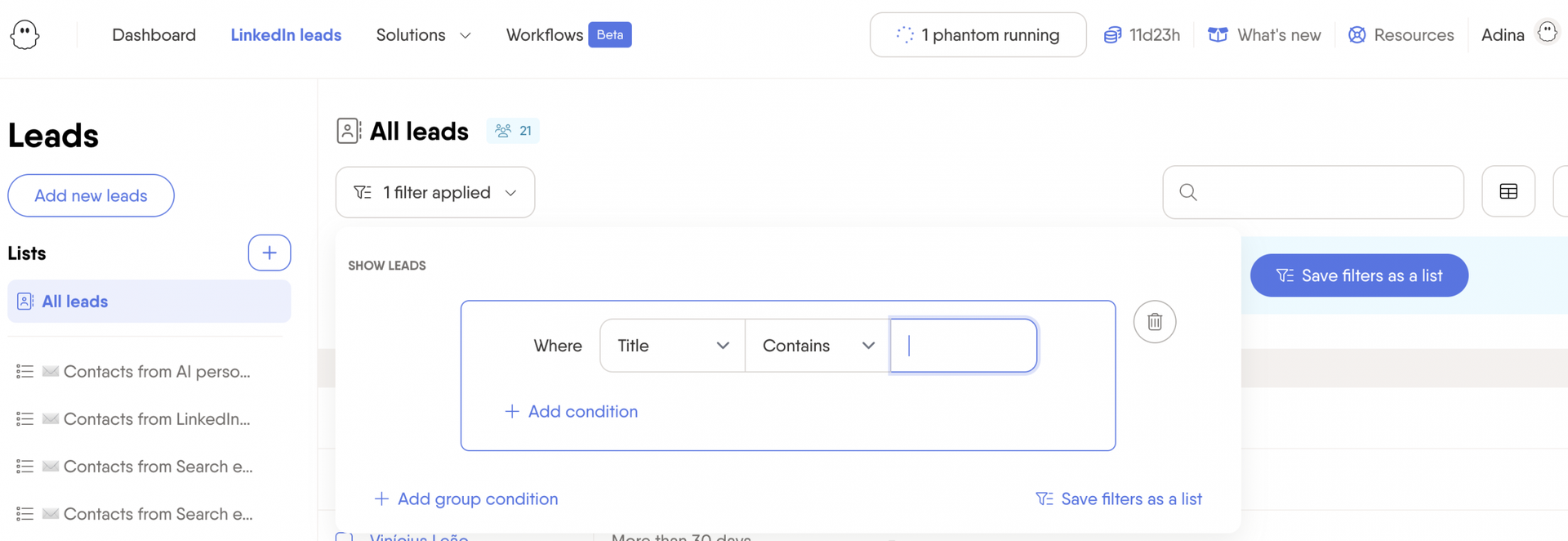
Personalize your outreach messages using AI
You’ve built a targeted list of prospects, now it’s time to connect. But generic connection requests are easily ignored. Personalized messages stand out and dramatically increase your chances of acceptance.
To make your connection requests irresistible, leverage the power of AI to craft hyper-personalized messages at scale.
Check out our AI prompting guide and learn how to get the most out of your AI prompts.
Use the lists you’ve previously built and run the PhantomBuster’s AI LinkedIn Message Writer automation. This will analyze the lead data to generate personalized connection requests in seconds.
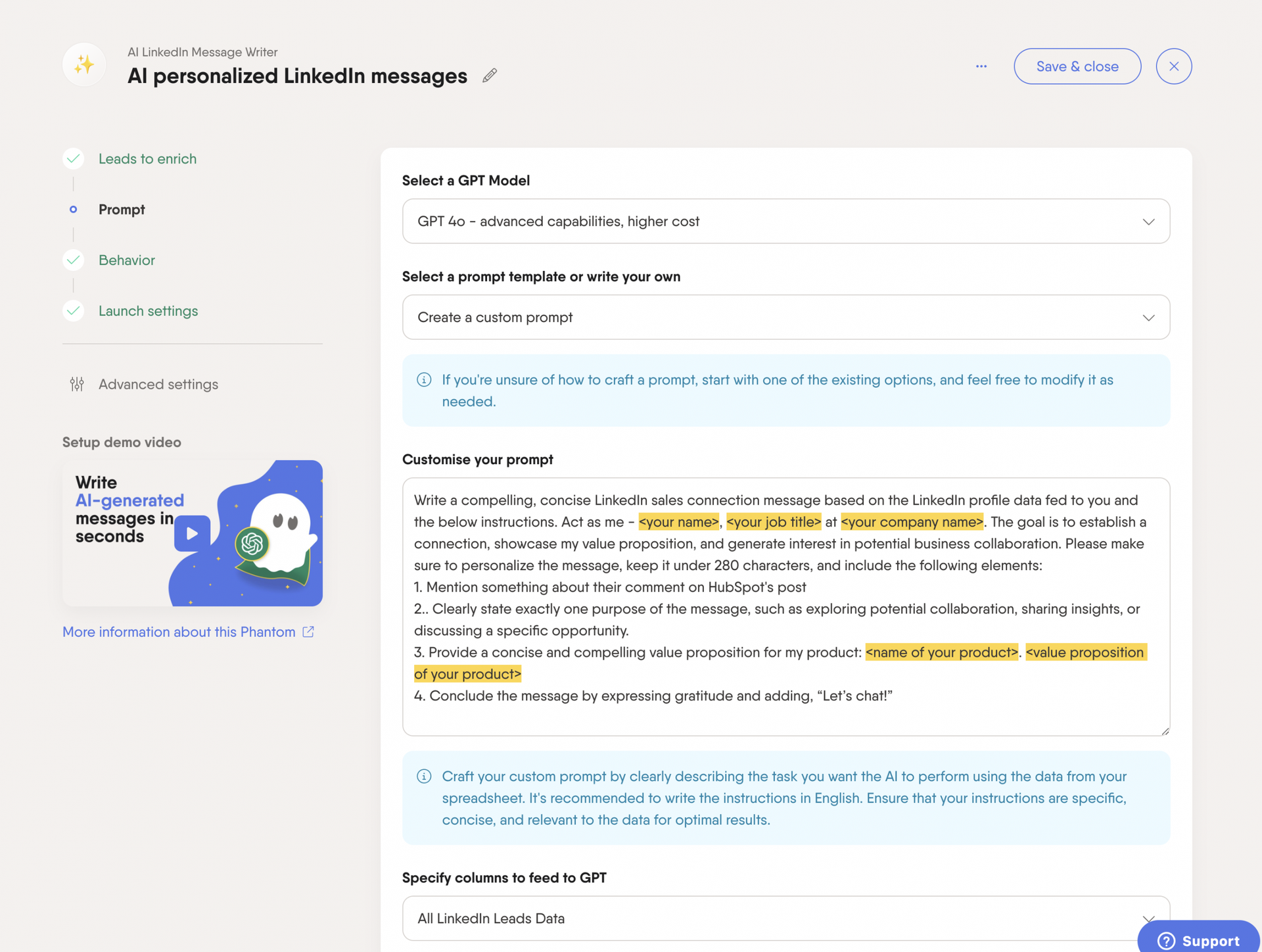
You’ll get unique connection messages that you can use to start your outreach.
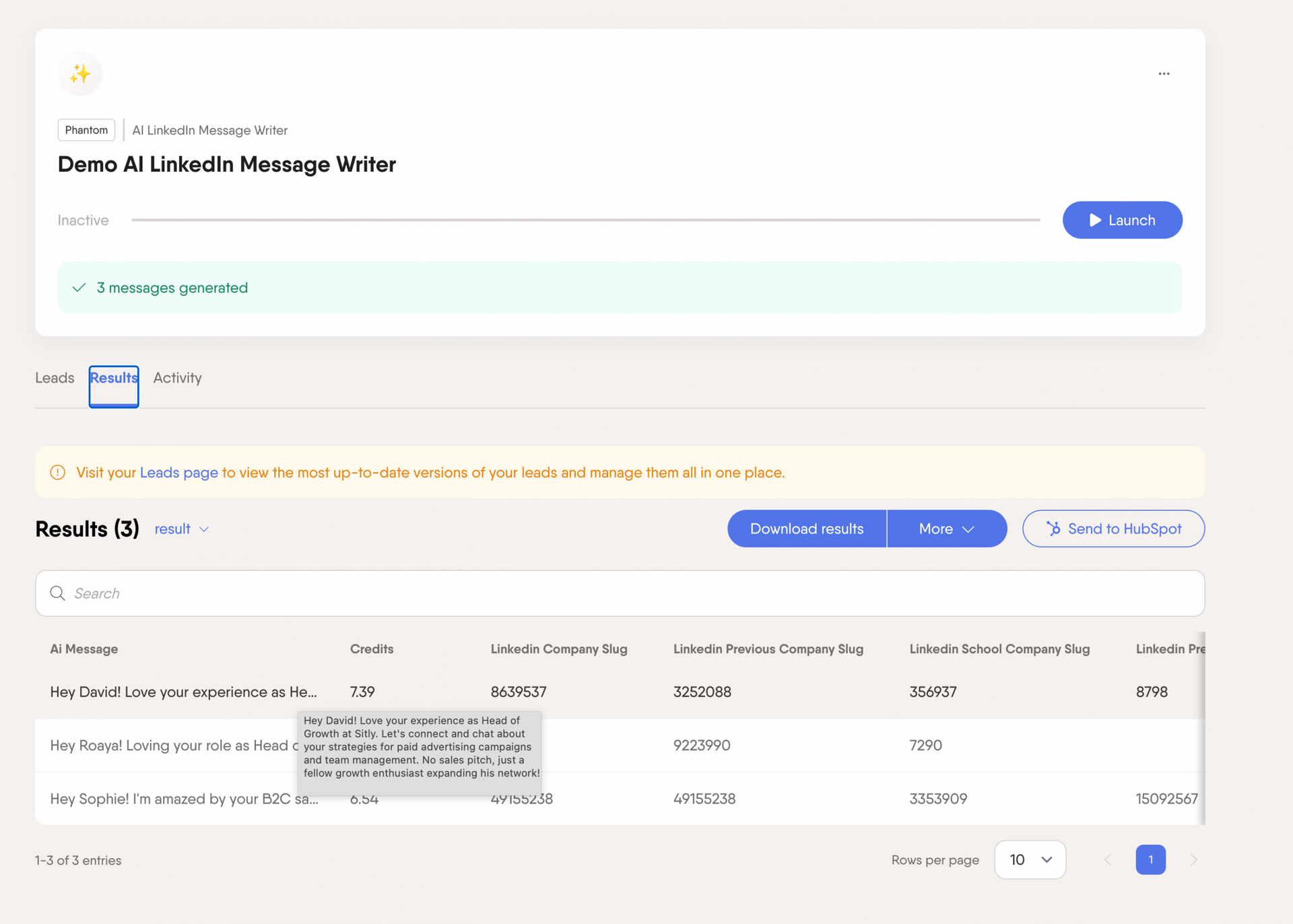
Best practices to support your social prospecting efforts
Want to build brand awareness, grow your pipeline, and close more business? These social prospecting practices can help.
Focus on platforms where your target audience is
identify where they are most active. If you’re targeting CIOs discussing AI, LinkedIn is a natural choice. Meanwhile, visually driven industries might find more success on Pinterest and Instagram.
Social listening tools can refine your approach by revealing where your competitors interact. If they consistently engage in specific LinkedIn groups or Twitter threads, that’s a strong signal that your audience is there, too.
Don’t do social prospecting manually – tools can help
Manually handling social prospecting can drain sales productivity. Automate key processes with social listening and lead generation platforms.
Tools like Hootsuite and Google Alerts can monitor industry trends and competitor mentions, flagging opportunities for engagement.
Then, use PhantomBuster to automate list building and qualification, and personalized outreach. This frees up your time to focus on conversations that drive sales.
Warm up your account before automating outreach at scale
LinkedIn’s algorithm is designed to detect unusual spikes in activity, which can lead to restrictions. To stay compliant, gradually scale your automated actions: commenting on posts, interacting with content, and scaling your outreach.
PhantomBuster helps manage this by offering recommended limits and customizable settings, allowing you to send invites safely.
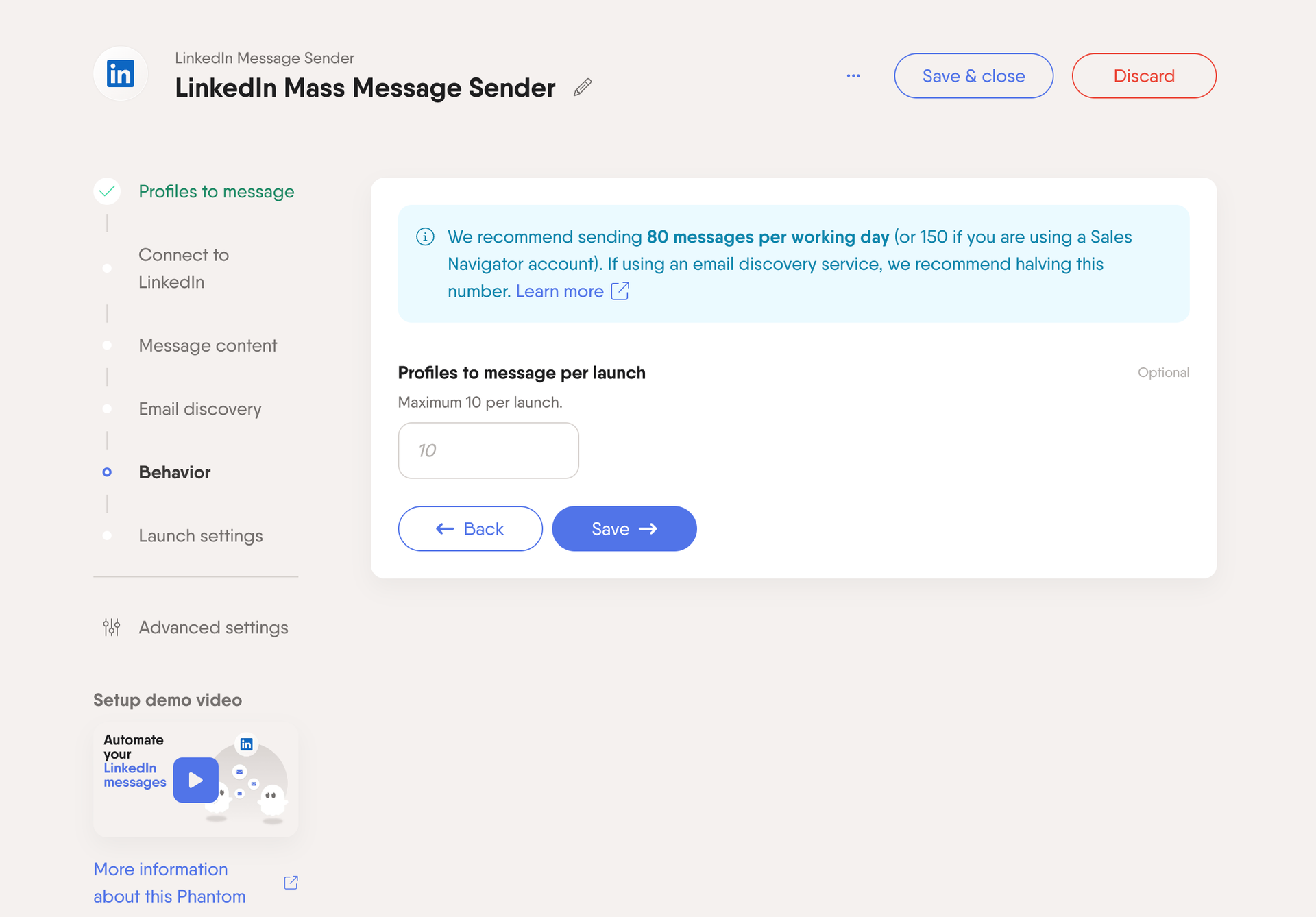
Time your outreach to stay relevant
You’ve identified high-intent prospects through social listening and targeted list building. To maximize your results, reach out at the right time – while their interest is still fresh and relevant.
The key to this technique?
An automated workflow that combines all the steps in one place: finding leads, creating personalized messages, and sending connection requests.
With PhantomBuster, you can automate this process to build and maintain relationships with key customers more effectively.
Disclaimer: The workflow is currently in beta and will be launched in Q1.
Provide value with relevant content tailored for each platform
Customer success stories are a powerful way to build trust and attract new prospects. To resonate with your audience, share those positive experiences in ways that work best on each social platform.
Here’s how:
- LinkedIn: Create carousel posts that show key metrics and ROI.
- Instagram: Share behind-the-scenes video snippets and Q&A sessions.
User-generated content is a powerful tool. Convert testimonials into quote graphics for Instagram and short video testimonials for TikTok. Make sure you share it directly to provide the best outcome.
Less is more: focus on quality over quantity
It’s easy to get caught up chasing every lead that comes your way. However, you’ll get better results by focusing your efforts on the prospects who are most likely to become valuable customers. According to a LinkedIn, 78% of social sellers outperform peers who don’t use social media, showcasing the importance of a focused approach.
This requires developing a clear understanding of your Ideal Customer Profile (ICP) and using a system to score your leads based on how closely they match that profile. Focusing your time on high-scoring leads can make you more effective and efficient.
Check out our lead scoring best practices guide for more tips.
Prioritizing quality over quantity maximizes efficiency and helps you build long-term, profitable relationships with the right people.
FAQ for social prospecting
What is the difference between social prospecting and social selling?
Social prospecting focuses on finding potential leads using social platforms and intent signals. Social selling focuses on nurturing those leads through trust-building and relationship maintenance.
Which social media platform is best for social prospecting?
The best platform for social prospecting depends on your audience and outreach strategy. LinkedIn suits B2B outreach. Facebook is best for broad demographic targeting. X is best for real-time conversations. Instagram works best for B2C visual content.
What are some common mistakes to avoid in social prospecting?
Some common mistakes sales teams should avoid when prospecting are sending generic, non-personalized messages, ignoring trigger events and intent signals, focusing on quantity over quality leads, and neglecting follow-ups and engagement with prospects’ content.
How can I measure the success of my social prospecting efforts?
You can measure the success of your social prospecting efforts by tracking connection request acceptance rates, leads generated in the sales funnel, conversion rate, and organic pipeline growth.
What are some good tools for social prospecting?
LinkedIn Sales Navigator is a good tool for B2B social prospecting, as it provides advanced search features to identify and track potential leads. PhantomBuster can help you automate sales prospecting, manage outreach sequences, and write personalized messages. Social listening platforms like Hootsuite and Sprout Social help track brand mentions and find relevant conversations across social networking platforms.
